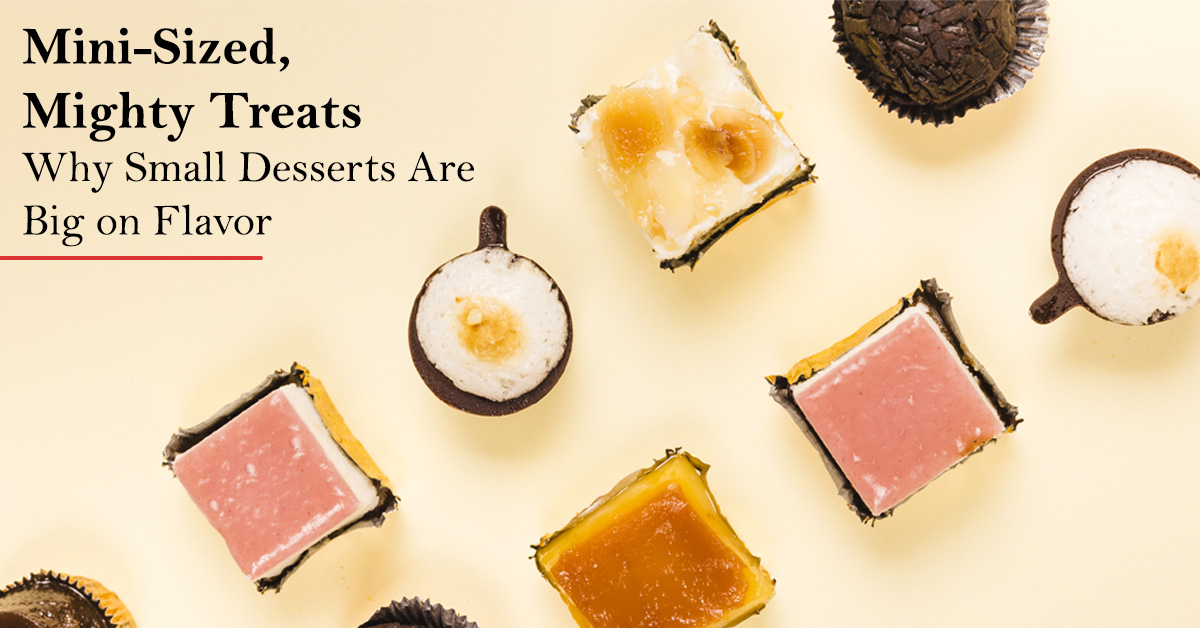Walk into a bakery in Chennai today and the counters don’t just hold large layered cakes anymore. You’ll notice trays of mousse shots, bite-sized tartlets, and rows of miniature cupcakes lined up in bright cases. These aren’t a side act; they’ve become a main attraction.
The shift isn’t only about eating less. Small desserts carry a different kind of punch. A spoonful of lemon mousse or a bite of chocolate tart delivers intensity because the balance of base, filling, and topping is tighter. The flavors hit quickly and cleanly, without the heaviness that often comes with larger servings.
For many home bakers, Small Dessert Recipes open the door to experimentation. A dozen tartlets can showcase different fillings in one batch. Mini cheesecakes cool faster, which matters in Chennai’s humid weather where waiting times test patience. And for anyone hosting, variety on the table counts more than size — guests want to taste more, not just more of the same.
Portion Control with Indulgence
Think of a wedding meal in Chennai. By the time desserts are served, people have already gone through starters, mains, and often more than one round of biryani. At that stage, few want a big slice of cake, but almost everyone still reaches out for something sweet. That’s where smaller servings come in.
In Chennai, this style has caught on strongly at weddings, Diwali celebrations, and even corporate events. Hosts prefer to serve guests a spread of Single-Serve Desserts so everyone can taste a little of everything. A bite of chocolate, a spoon of fruit tart, a mouthful of coffee mousse — the variety becomes the highlight.
For the guest, there is no guilt in going back for seconds because the servings are designed to be light. For the baker, it’s a chance to showcase multiple recipes on the same table. Small desserts prove that restraint doesn’t reduce pleasure; it often makes each flavor stand out more.
Creativity in Presentation
With small desserts, the plate itself becomes part of the art. A large cake often dominates by size, but miniatures allow more freedom. Rows of tiny pavlovas topped with fresh fruit, mousse served in clear shot glasses, or bite-sized cheesecakes lined neatly on a platter — each piece looks complete, yet together they create a striking display.
In Chennai, presentation matters almost as much as flavor. Customers often pull out their phones before taking the first bite, which means bakers need to think visually. Mini Cakes and Pastries arranged on tiered stands or Mini Dessert Cups layered with colors photograph beautifully and travel well on social media. For young bakers building a name, that visual impact brings recognition faster than a single large cake ever could.
Training reflects this demand. Many baking courses in Chennai now dedicate time to plating and styling, not just mixing and baking. Students learn how to balance color, height, and texture on a serving board, how to pipe consistently across dozens of pieces, and how to finish with garnishes that hold up in the city’s humid conditions.
What emerges is a form of edible design. Each small dessert is crafted to be complete on its own, but when displayed together, they transform the table into a showcase of detail and imagination.
Practical Benefits for Bakers
Miniature desserts make day-to-day work easier. They go into the oven and come out quicker, so a baker can finish more batches in less time. Cooling also takes minutes instead of hours, which matters in a hot city like Chennai where refrigeration space is always under pressure.
Testing new flavors becomes less risky. If a dozen mini tartlets don’t turn out well, the loss is small compared to throwing away a full-sized cake. For anyone selling commercially, uniform sizes also make costing simpler; every piece has a clear price, and customers understand what they’re paying for.
There’s also the transport factor. A tray of minis usually survives Chennai traffic better than one large, cream-heavy cake that can collapse or smear. It’s no surprise that Cake Classes in Chennai now teach these techniques early, showing students how practical choices can save both time and money in real kitchens.
Cultural Shifts Driving Popularity
Dessert habits in Chennai aren’t what they used to be. A decade back, most people expected a big slice of black forest or butter cake. Now the same crowd asks for tasting plates — mousse in a cup, a small tart, maybe a bite of cheesecake. The shift came partly from global cafés and patisseries setting up in Indian cities, but it’s also about younger customers wanting choice over size.
Health concerns have added to it. A smaller portion lets people enjoy sugar and cream without feeling they have overdone it. Bakers meet that demand with trays of Mini Layered Desserts and other single-serve items that carry strong flavor in a few spoonfuls.
What looks like a trend has actually become the new normal in Chennai kitchens. Customers expect smaller, varied, and neatly presented sweets, and bakers who don’t adapt find themselves left behind.
Tips for Aspiring Bakers in Chennai
Starting small makes the learning curve easier. A tray of mini cupcakes or a dozen tartlets gives enough practice with mixing, baking, and decorating without the stress of managing a large cake. Even simple brownies cut into neat squares teach control over portioning and consistency. Once those basics are steady, moving into more detailed desserts feels natural.
Chennai bakers often find inspiration in local flavors. A mousse sweetened with jaggery, filter-coffee set as panna cotta, or cheesecakes layered with coconut ladoo notes — these feel familiar to guests here, yet different enough to grab attention on a table. They’re the kinds of experiments that usually get remembered at family functions.
Proper guidance matters. Structured Baking Classes in Anna Nagar spend time on more than recipes. Students are shown how to pipe evenly across dozens of pieces, how to adjust recipes for smaller portions, and how to keep garnishes looking sharp despite the city’s humidity. Those details separate a hobby bake from something that can be served, sold, or showcased.
Conclusion
Mini desserts work because they answer two needs at once. People want to taste something rich, but they don’t want the heaviness that follows a full portion. Bakers want room to try different flavors without wasting trays of ingredients. Small sizes solve both.
Chennai’s food scene has always absorbed new ideas while holding on to tradition. Small sweets fit naturally into that mix — they sit comfortably alongside a plate of ladoos at a wedding or appear as mousse cups at a café. The message is clear: size does not set the value of a dessert. What matters is the experience it creates, and in that, the smallest piece can leave the strongest memory.


